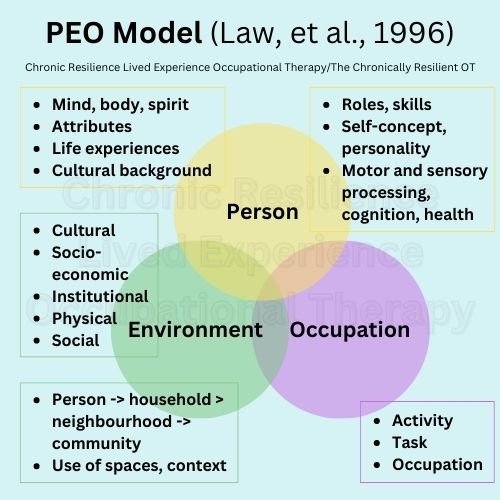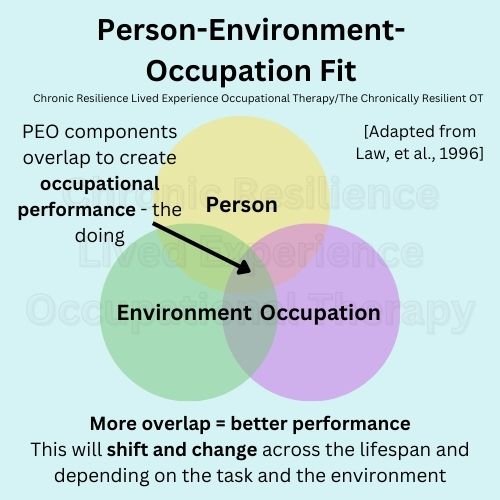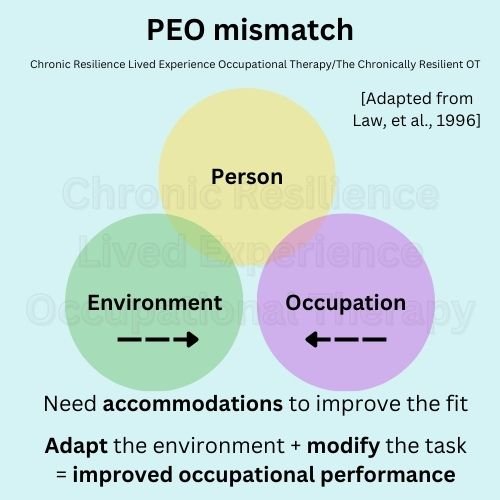Accommodations make a difference
Key points:
The ability to do a task can be impacted by many factors.
On any given day, the combination that results in overload can be different.
Simple accommodations can increase someone's enjoyment of, or capacity and ability to do, a task.
[Disclaimer - one blog cannot possibly cover all the individuality and nuance of accommodations that vary person to person and in different settings. For individual advice please contact your health professional or look up the relevant legislation, process and resources for your setting and country. Written by a disabled, chronically ill and neurodivergent occupational therapist. I have used both person first and identity first language interchangeably as I am exploring which I prefer.]
Image description: a 3 panel comic with a brown background. The heading reads ‘Accommodations make a difference’, below the heading text says ‘The ability to do a task can be impacted by many factors. On any given day, the combination that results in overload can be different.
Simple accommodations can increase someone's enjoyment of, or capacity and ability to do, a task.’ The first panel has a scale from 0-100 with different coloured boxes from green at the bottom to red at the top, the boxes in ascending order are: tight clothes, bright lights, multiple noise sources, hunger, strong perfume, didn’t sleep well, need a break, don’t understand task, high pain levels. The top box sits on top about to fill up the scale to 100 – the box says ‘someone asks a question.’ Above this text says: One more task demand or something unexpected could result in overwhelm/ meltdown for this person. Middle panel: a bulleted list says ‘What if the same person has: Taken a break, Had a snack recently, Can wear comfy clothes to work, Has been given clear task demands, Colleagues don't wear strong perfume, Can wear noise cancelling headphones’. Below this are some of the coloured boxes from the first panel all smaller with a spiky circle that says ‘these factors now have less impact.’ Third panel: text at the top says ‘With accommodations in place, the same demand, 'someone asking a question', doesn't have the same impact.’ This is the difference simple accommodations can make. There is the 0-100 scale but now only 3 boxes (bright lights, didn’t sleep well, high pain levels) are filled in, a yellow box (someone asks a question) fits on top and doesn’t cause overwhelm – this is the difference simple accommodations can make.
So what do I mean by accommodations?
Accommodations
“1 - a room, group of rooms, or building in which someone may live or stay;
2 - a convenient arrangement; a settlement or compromise;
3 - the process of adapting or adjusting to someone or something;
Origin early 17th century: from Latin accommodatio(n-), from accommodare ‘fit one thing to another’.”
The closest is the third meaning “the process of adapting or adjusting to someone or something”. But the definition still doesn’t quite fit as what I am talking about with accommodations is changing the task or environment to suit the person and setting them up for success in their chosen activity.
According to the United Nations Convention on the Rights of Persons with Disabilities (Office of the High Commissioner for Human Rights, 2006)
"‘Reasonable accommodation’ means necessary and appropriate modification and adjustments not imposing a disproportionate or undue burden, where needed in a particular case, to ensure to persons with disabilities the enjoyment or exercise on an equal basis with others of all human rights and fundamental freedoms”
Reasonable accommodations could include adjustments to a job, workplace or hiring process, in educational settings it could be modifications and adjustments to tasks or environment. A study by Ozelie et al. (2022) looked at accommodations for Occupational Therapy students on placements and they defined reasonable accommodations as “a change, adaptation, or modification to a policy, program, service, or workplace that allows a qualified person with a disability to participate fully in a program, take advantage of a service, or perform a job.” They also explored unreasonable accommodations “defined as one that would introduce undue hardship to an employer’s operation, including imposing significant difficulty, excessive cost, removing essential job functions, or placing additional workload on another employee.”
The difference between accommodations and modifications
Accommodations look at how someone is doing something. Accommodations focus on the process and do not change the expectations or requirements of a task, e.g. extra time, pencil grip, interpreter, text to speech software.
Modifications look at what someone is doing. Modifications change the task, expectations, requirements or material, e.g. shorter or less complex task, different assignment or text to read.
For some good examples of the differences see here and here.
So who needs accommodations?
Accommodations can be used in workplaces, schools, healthcare settings, public places and any other environment. People may need accommodations because of disability, illness, injury, religious beliefs or family commitments. Accommodations support people without disabilities too. For example curb cuts make it easier for people with prams or trolleys to cross the road. If you want to know more about curb cuts, this podcast goes into the story of disabled activists throughout the 1970s-1990s pushing for better access, including getting curb cuts. Universal design is a topic for another time.
The type of accommodations needed will vary person to person and depend on the nature of the task and the environment. Employment New Zealand (2023) gives a range of examples of reasonable accommodations, including some specific suggestions for accommodations around medication and mental health. They also note that some accommodations such as flexible working arrangements can benefit all employees. The Office for Disability Issues also have a resource on accommodations that outlines what is reasonable, how accommodations can be provided and examples of what this might look like in the workplace - for more details check it out here.
Why do we need accommodations?
The Bureau of Labour Statistics (2023) in the United States reported that In 2022 only 21.3% of people with disabilities were employed compared to 65.4% of people without disability, with an unemployment rate of 7.6%, which was just over double that of people without disability. Disabled workers were also more likely to work part time or be self employed, less likely to work in management or professional roles and have a much lower income (source here). Unemployment rates were higher for disabled people who are also Black or Hispanic, than for disabled white people. It’s also important to note that all of these numbers have been improving in recent years so shifts are happening in the right direction.
Note: These stats don’t take into account the disabled people who do unpaid caring work looking after family members. I’d also like to note that employment is not a goal for all and people don’t need to be employed to have worth and value.
Accommodations can reduce barriers to working for people with disabilities and make workplaces more accessible. According to a study by Anand and Sevak (2017) most common accommodations were a flexible schedule (50%), a job coach or training (41%), arranged assistance from co-workers (32%), and modified job duties (28%), but many people are not receiving the accommodations they need, especially those with physical disabilities. Accommodations are also necessary for many children in schools.
People seem to mostly talk about accommodations for schools and workplaces, but there are also things people do at home and in their own lives to accommodate their own needs. For me some examples in my day to day life are: sleeping with a weighted blanket and audiobook, having a roster for chores, writing tasks on a to do list, using a calendar and setting reminders, having items out and visible, and so many more. I’m sure you have your own list of things you do daily that you might not even realise are accommodations!
The PEO model as a framework for determining appropriate accommodations
The Person-Environment-Occupation (PEO) model is a useful way to explain what an Occupational Therapist does without too much jargon. The PEO model was developed by Law et al. (1996) to illustrate how interactions between people, their occupations and their environments impacts their occupational performance. Occupation here meaning anything a person does with their time (activities, tasks, hobbies, roles, etc.), not just what they do for work. When all 3 components are in balance the person is able to do the things they want and need to do – termed person-environment-occupation fit. Sometimes the circles move and are not in balance, and supports are needed to improve the fit. This is where accommodations come in, looking at the interactions between the person, the environment and their occupations, adding supports to maximise the fit and improve occupational performance. This could look like changing the environment by giving someone a footstool or making a space physically accessible, or adapting the occupation to include more breaks and explicit instructions. Accommodations for the person could include noise cancelling headphones to manage sensory sensitivities or using a calendar with reminders to support executive functioning.
Image descriptions: a series of 3 graphics with a blue background. Graphic 1 – title: PEO model (Law, et al., 1996). Three overlapping circles represent the three components of the model: person, environment and occupation. Next to each circle is a box that describes what is included in each component. Person (yellow circle): Mind, body, spirit, Attributes, Life experiences, Cultural background, Roles, skills, Self-concept, personality, Motor and sensory processing, cognition, health. Environment (green circle): Cultural, Socio-economic, Institutional, Physical, Social, Person -> household > neighbourhood -> community, Use of spaces, context. Occupation (pink circle): Activity, Task, Occupation. Graphic 2 – title: Person-Environment-Occupation Fit. The same 3 coloured overlapping circles with an arrow pointing to the area of overlap labelled ‘PEO components overlap to create occupational performance - the doing’. More overlap = better performance. This will shift and change across the lifespan and depending on the task and the environment. Graphic 3 – titled: PEO mismatch. The three circles are no longer overlapping, the environment and occupation circles have shifts towards the edges of the graphic, arrows under the words indicate the need for movement. Need accommodations to improve the fit. Adapt the environment + modify the task = improved occupational performance.
How do you know what helps you?
Working out your needs is an important step as if you don’t know what makes things harder for you it’s difficult to know what accommodations to use or ask for. You could start by asking yourself some of the following questions:
What do you already do?
What things do you find difficult?
What helps you to engage in something? What makes it harder?
Do you have sensory sensitivities? Physical disability? Executive functioning issues? Pain? Fatigue?
What things bring you closer to overwhelm?
What makes you more vulnerable to feeling overwhelmed?
What helps you to start a task or stay focused?
What sort of environment is helpful? What things in the environment make it harder to focus?
How do I know when I’m close to overwhelm? What does it feel like?
It’s also important to notice and celebrate when things are going well and what signs indicate that you’re engaged and motivated as this can give you some clues for strategies that might be helpful.
Once you know a bit about what you find helpful and what makes things harder you can start to brainstorm ideas for what you might need to add or take away from the task or the environment that will make it easier. Maybe it’s something simple like enlarging the text or maybe it’s a bigger thing like having a specific physical set up with some adaptive equipment like eye gaze technology for using the computer.
Getting accommodations
I won’t go too much into detail in this section as the legislation and process differs from country to country and depending on what setting you’re in. I will also focus more here on workplace accommodations as I am less familiar with school settings.
It’s important to know your rights and what you’re entitled to.
In New Zealand the Human Rights Act 1993 makes discrimination unlawful, including for disability. So if accommodations are not provided, this can be discrimination and you can make a complaint to the Human Rights Commission.
Check the articles of the United Nations Convention on the Rights of Persons with Disabilities (Office of the High Commissioner for Human Rights, 2006).
In the United States refer to The Americans with Disabilities Act (ADA) https://www.ada.gov/
Te Kāhui Tika Tangata/Human Rights Commission recommend that when asking for accommodations people describe the barriers and solutions clearly, refer to relevant legislation if necessary, and ensure accommodations are confirmed in writing. You do not necessarily need to disclose a diagnosis as this is private medical information, but you will need to describe the situation and current barriers that interfere with participation. For example you might request to be able to wear noise cancelling headphones while working due to a sensory sensitivity as you are having difficulty staying focused and this will help you stay on task.
————————————-
Accommodations are as individual as the people who need them. There are some overall policies and strategies that can be adapted to support all workers and students and then there will be specific modifications and accommodations tailored to the individual need. You may need support to identify and ask for accommodations - you may be able to use an advocate, union delegate or health professional for support. People have the right to engage in their chosen and valued occupations and accommodations can help reduce the barriers to participation.
Additional references not already linked
Anand, P., & Sevak, P. (2017). The role of workplace accommodations in the employment of people with disabilities. IZA Journal of Labour Policy, 6(12). https://doi.org/10.1186/s40173-017-0090-4
Bureau of Labour Statistics (2023). Persons with a disability: Labour force characteristics – 2022. Retrieved April 14th 2023 from https://www.bls.gov/news.release/pdf/disabl.pdf
Employment New Zealand (2023). Reasonable accommodation (measures). Retrieved April 14th 2023 from https://www.employment.govt.nz/workplace-policies/employment-for-disabled-people/reasonable-accommodation-measures/
Law, M., Cooper, B., Strong, S., Stewart, D., Rigby, P., & Letts, L. (1996). The person-environment-occupation model: A transactive approach to occupational performance. Canadian Journal of Occupational Therapy, 63(1), 9–23. https://doi.org/10.1177/000841749606300103
Office of the High Commissioner for Human Rights (2006). Convention on the Rights of Persons with Disabilities. Retrieved April 16th 2023 from https://www.ohchr.org/en/instruments-mechanisms/instruments/convention-rights-persons-disabilities
Ozelie, R., Bock, J., Gervais, S., Schneider, L., & Silhavy, C. (2022). Is It Reasonable? Reasonable and Unreasonable Accommodations for Occupational Therapy Students in Clinical Settings. The Open Journal of Occupational Therapy, 10(2), 1-15. https://doi.org/10.15453/2168-6408.1913.



